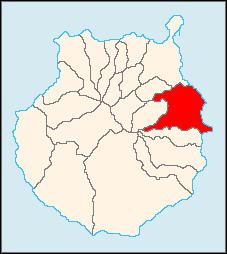Country Spain Demonym(s) Teldenses Area 102.4 km² | Elevation 130 m (430 ft) Time zone CET (UTC+1) Population 102,076 (2014) Local time Tuesday 11:51 AM | |
 | ||
Weather 19°C, Wind NE at 26 km/h, 57% Humidity | ||
Telde is a town and a municipality in the eastern part of the island of Gran Canaria, Canary Islands, overseas (Atlantic) insular Spain.
Contents
- Map of Telde Las Palmas Spain
- History
- Ecclesiastical History
- Residential Ordinaries
- Titular see
- Economy
- Main sights
- Climate
- Education
- Sister cities
- Notable locals
- References
Map of Telde, Las Palmas, Spain
It is the second most populous municipality on the island, with a population of 102,170 (2013). Its area is 102.43 km2 (39.55 sq mi). The city is the oldest and the first capital of the island of Gran Canaria, founded before 1351, a former medieval bishopric and present Catholic titular see.
The city Telde is located 4 km from the coast and 16 km south of the island capital Las Palmas. The GC-1 motorway passes east of the city. The Gran Canaria International Airport is located in the subdivision of Gando, south of Telde.
History
Before the Spanish invasion Telde was the eastern centre to the aborigines of the island, and the renowned aborigen Doramas is believed to have lived here. Early records point to about 14,000 aborigen dwellings here in Telde at the time of conquest, and Telde is the spot where the famous Idolo de Tara figure—currently housed in the Museo Canario in Las Palmas—was discovered.
It was created by papal decree is 1351. Today Telde is Gran Canaria's second city with a population over 100,000. The historic old town area of Telde is particularly popular with visitors.
Ecclesiastical History
On 1351.11.07 was established the Diocese of Islas de la Fortuna (español) / Isola de Fortunate (Italiano) / Insulas Fortunatis (Latin), meaning 'Fortunate islands', nickname of the Canaries, territory split off from the Balearic Diocese of Mallorca, as suffragan of the (Andalusian) Metropolitan Archdiocese of Seville.
Renamed in 1369 after its see as Diocese of Telde (Spanish) / Telden(sis) (Latin adjective).
On 1404.07.07 it lost territory to establish the Diocese of Rubicon.
In 1441 it was suppressed, without direct successor.
Residential Ordinaries
(all Roman Rite and members of Latin congregations)
Titular see
In 1969 the diocese was nominalyy restored as Latin Titular bishopric of Telde (Spanish) / Telden(sis) (Latin adjective).
It has had the following incumbents, none yet of the fitting Episcopal (lowest) rank :
Economy
In the past, Telde was an agricultural community, the main crops being sugar canes, vineyards, bananas and tomatoes. Today the surrounding area of Telde is quite heavily industrialised, becoming the industrial centre on the island.
Main sights
The church San Juan Bautista (John the Baptist) de Telde is the true spiritual centre of Telde. Located in the square of the same name and founded in 1483, the old church was erected by the Garcia del Castillo family at the time of the town's foundation. It still has the original gateway, an example of Sevillian-Portuguese Gothic architecture. The towers, however, are an example of early 20th neo-Gothic construction. The real marvels are inside the building: the statue of Christ on the main altar, made from corn dough by the Purépecha Mexican Indians, brought here before 1550, the Flemish Gothic main altar, which dates back to before 1516, and the triptych of the Virgin Mary, brought from Flanders, also in the 16th century, depicting five religious scenes.
Telde has 101 archaeological sites and 709 listed sites of ethnographic interest. The number of sites increases each year, as do new aspects of old fields, but most are in disrepair and many are disappearing. Some of the most prominent are the coastal town of Tufia, in good condition and extensively excavated by archaeologists; Four Doors (Cuatro Puertas), a large cave with four doors located on top of a mountain overlooking the plain adjoined to a village of cave houses with collective barn at the back; the caves of Tara and Cendro, remains of the ancient centre of population; the town of Draguillo on the border with Ingenio; las cuevas Chalasia which consist of a labyrinthine series of artificial caves linked by tunnels; and the impressive necropolis of Jinámar which includes more than 500 tombs of various types.
Climate
Telde has a moderate desert climate.
Education
Lycée Français René-Verneau, the French international school of Gran Canaria, is located in Telde.
